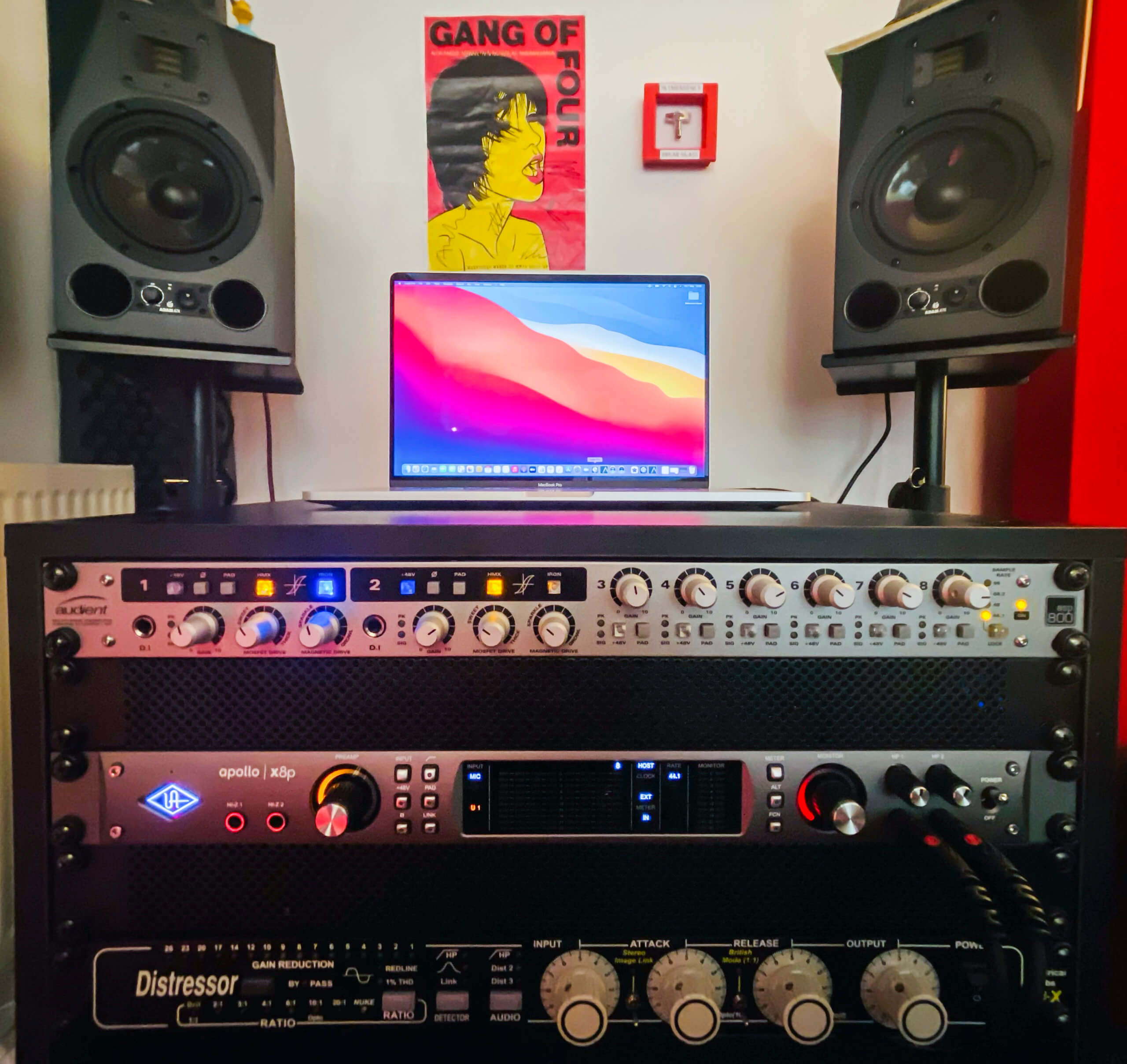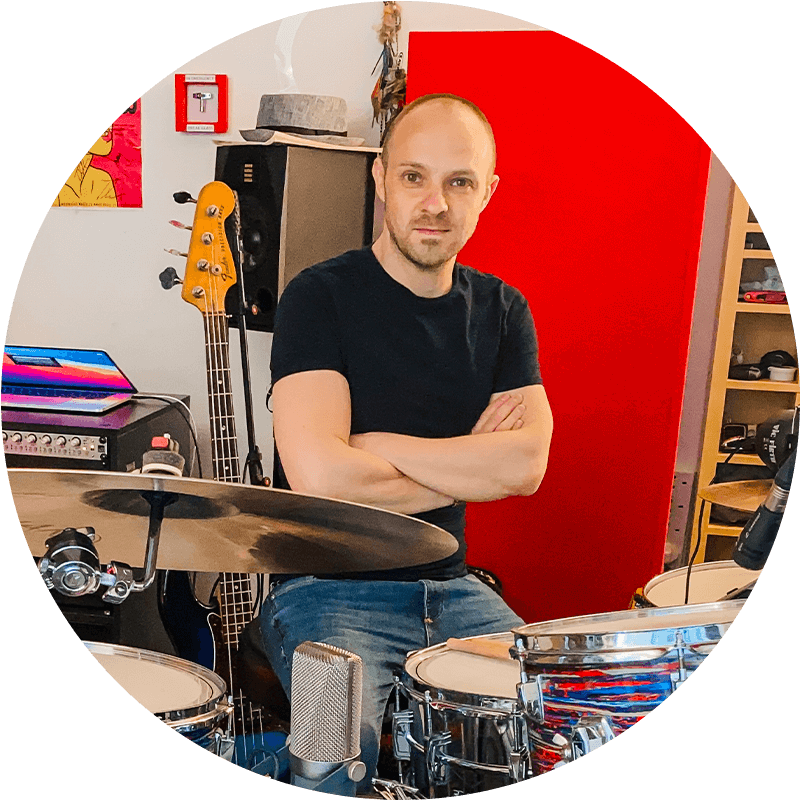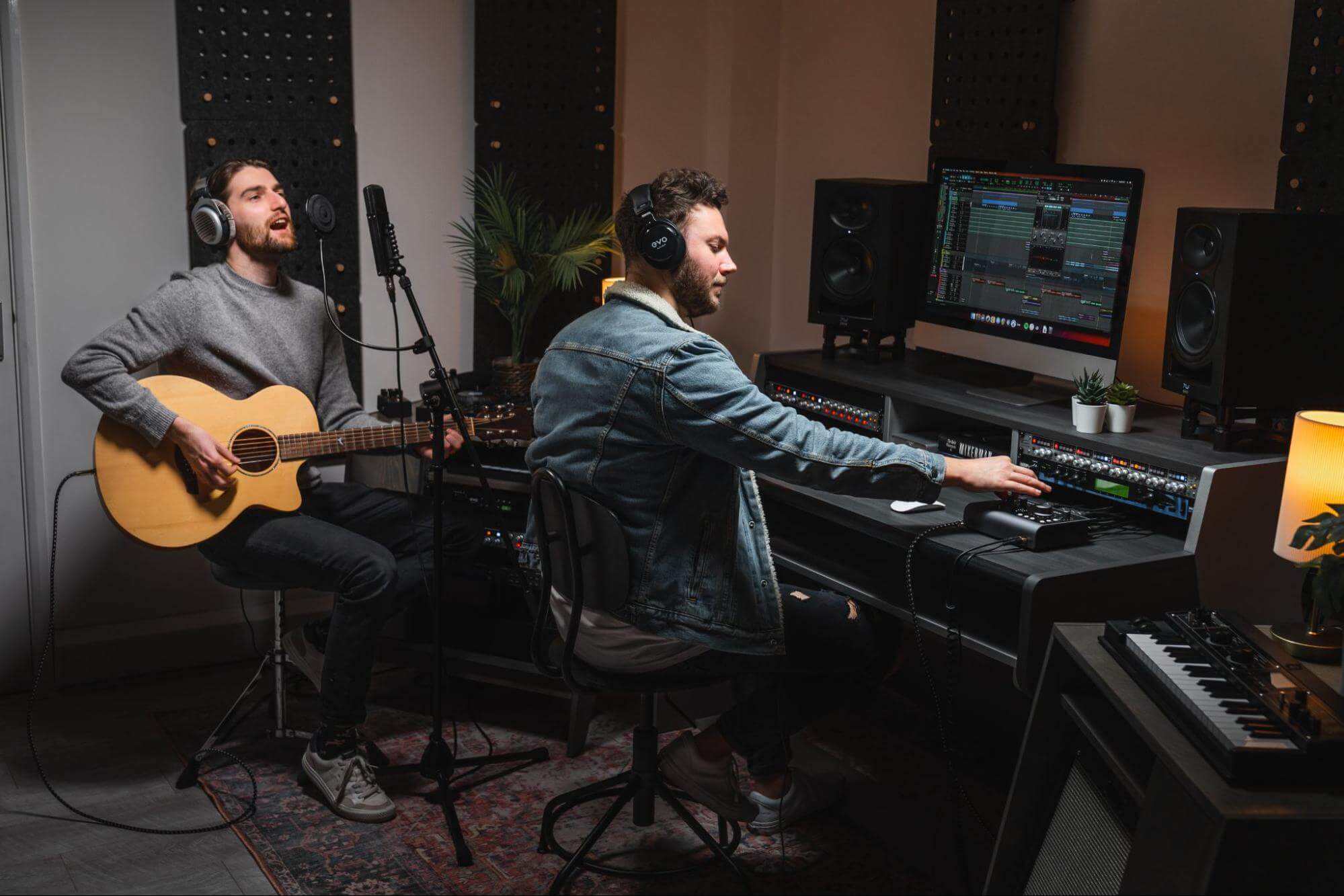KIT
For me, this is the centre of everything – it’s usually the core of your problems, and the source of most of your solutions. If you think of music like a meal, your instrument is the ingredients. All of the mics and the plug-ins and the mixing techniques come after you get that acoustic sound.
I’m using a 1968 Ludwig kit with a mix of Ludwig Snares. I find a different snare can transform the vibe of the kit and certain songs need really specific things. If I’m going for a vintage vibe, I use a 60’s 402, but I also have a Black Beauty for more modern tracks… and a few fun things, like the Sonor Jungle snare, for when I want a totally different vibe.
It sounds obvious, but make sure your kit is properly tuned. Look for resonance, rattles – any sound that you don’t like, find ways to kill it. Whether it’s gel pads, using gaffer tape, putting a cushion under your floor tom, using a ring on your snare – there are lots of little changes that you can make before you start recording that mean you’re capturing a good kit sound. Producers and mixers often compliment me on the sounds I get – and a lot of it is just about not allowing anything you don’t like the sound of to slip through the net.
CYMBALS
I keep cymbals to a minimum. I find with a really stripped back setup, I can use a variety of overhead patterns and they all sound good – plus there’s less high frequency information ringing out which can conflict and bleed into the kit mics. It’s often one ride, one crash and hats. Again, I’ll use different cymbals depending on the track, but I tend to keep it to just three. It’s an approach I’ve always enjoyed in Steve Jordan’s recordings – minimal setup and always choose the right sounds.
MICS
8 channels into the Audient
A pair of Coles ribbon mics for overheads – they sound great on pretty much everything, have a fantastic dynamic range and sound warm and clear without ever getting glassy or harsh.
A Shure SM57 on the snare – this is a classic choice. It’s an industry standard for a reason. It picks up the crack and the thump of the snare and if you angle it right, it won’t pick up too much hats or kick drum.
An AKG D112 on the kick – again, this is one of 3 or 4 mics that everyone uses on a kick drum. It does what it’s supposed to do – picks up lots of heft in the low and a decent amount of detail in the mids and highs.
A Solomon sub kick – I use this for ultra-low end – making sure I can tweak the kick sound while still maintaining a really solid sub presence.
A Beyer m160 for hats – a great mic for picking up detail and energy on the hats
Sennheiser e604 clip-ons for rack and floor toms – these are a great mic for picking up the low fullness, but also the smack when you hit toms. Also, I love clip-ons, because they make it so much easier to move the mic placement from the drum stool if I need to and it’s always great to avoid cluttering up the studio with another 2 or 3 mic stands.

The Audient ASP800
I use all 8 XLR inputs for the mics.
Channels 1 & 2 are the retro channels, so I generally run my overheads through them. For me, the greatest flexibility in the kit sounds comes from changing the tonal quality of my overheads. If a producer wants drastically different kick or snare sounds, they can drop in samples, but the overheads are there as a sort of sonic signature. So being able to warm them up for a Motown track or a ballad and then going super clean and crisp for a modern hard rock tune gives me a lot more range in my sounds.
If someone wants a squashed or driven snare or kick, I’ll sometimes swap out the kick and snare into 1&2, but that’s only on the odd occasion.
With the other channels, I’d simply dial up the gains, check the phase relationships between the mics, play in, solo and review my channels in Logic and then make tweaks to find the sweet spot on each one. Once I’ve got the levels set for my kit, I’m a huge fan of just leaving things alone and focusing on the music. The key is to spend a lot of time at the very start getting your space sounding as good as it can be. The more care you take at the beginning, the more free you can be to create music and really get lost in the performance. With great sounding, reliable gear, you know that the recording part of it is taken care of and you can just be the drummer for a few hours.

SPACE
Try and stay away from reflective surfaces (like windows) and buy or create baffles. Also, try not to set your kit up right next to any walls – they can make strange things happen. I’ve bought a set of great studio baffles that absorb a lot of the sound, but I’ve seen people hang material, curtains, duvets, blankets etc from the ceiling or on their walls that do a great job of preventing nasty reflections on a very low budget.
Final thoughts:
• Always ask for: Tempo / Sample Rate / Bit Rate, from the person you’re recording for.
• Get familiar with Dropbox / WeTransfer or Google Drive – everyone uses them for file delivery and you should too.
• Experiment with sounds, but don’t get lost making continuous tweaks.
• Imagine a sound or vibe that you want and aim for it, rather than just trying things with no real focus.
• Tune your drums!
• Experiment with dampening techniques.
• Do your research. Read or watch interviews with drummers you love. Find out how they got their sound. Also, check out the producers who recorded their drums – you can learn SO MUCH from a good YouTube rabbit hole session.

About the author
Jon was a member of Gang of Four 2013-2019. He plays drums on their 2015 album ‘What Happens Next? And the live album ‘Live, In The Moment’, their first live release since 1984. Jon has toured in the UK and Europe with the band and played drums on the latest album ‘Happy Now’ and last performed with them live on bbc 6 music in 2019. GO4-“Change the locks“
In 2016, Jon toured with singer Ian Gillan (Deep Purple) and Don Airey (Deep Purple) backed by a 40-piece philharmonic Orchestra. In 2018 Gillan released 3 of shows on 3 separate platforms, Saint Petersburg on vinyl, Warsaw on cd and itunes and The Moscow Kremlin Theatre on blu Ray. Gillan/ Moscow
Jon is Don Airey’s recording and touring drummer and plays drums on his 2018 solo album “One Of A Kind” and his latest live album, released in 2021 – ‘Live in Hamburg’ which went to no. 1 in the German rock chart “lost in Hollywood live in Hamburg.
For more drumming tutorials and content, make sure to check out Jon Finnigan on his Website or Instagram.
Our Products
-

2in | 2out Audio Interface
-

10in | 6out Audio Interface
-

10in | 14out Audio Interface
-

20in | 24out Audio Interface
-

24in | 32out Audio Interface
-

2in | 2out Audio Interface
-

4in | 4out Audio Interface
-

24in | 24out Audio Interface
-

Everything you need to start recording
-

8 Channel Smart Preamp with AD/DA
-

8 Channel Mic Pre & ADC
-

8 Channel Mic Pre + Tone Control
-

Modular Analogue Recording Console
-

Small Format Analogue Recording Console
-

Small Format Analogue Recording Console
-

Immersive Audio Interface and Monitor Controller
-

Desktop Monitor Controller


